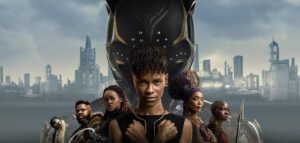Themes of grief and loss complement the commentary on the destabilization of African and Mesoamerican lands by imperialist countries in a film full of setbacks.

The Marvel Studios logo is usually greeted with applause as images of previous projects rapidly cycle through before the start of every movie. That is not the case for Black Panther: Wakanda Forever. The film begins with Shuri (Letitia Wright) struggling to perfect the Heart-Shaped Herb. With a sample that has faint chances of being successful, Shuri decides to take it to T’Challa only to be stopped by Queen Ramonda (Angela Bassett). The resounding silence of audiences holding their breath as the screen fades to Chadwick Boseman’s homage, images and clips of his work in the MCU that transform to a purple Marvel Studios logo, sets the tone for the film.
The film is centered on Shuri’s emotional journey to accepting the passing of her brother, King T’Challa, becoming the Black Panther, and facing off against an antagonist similar to the one her brother faced, Namor. Shuri’s character is shown as a mentor to Ironheart Riri Williams (Dominique Thorne) who relates with being young and brilliant, and also as a mentee to M’Baku (Winston Duke) and Okoye (Danai Gurira). The internal battle inside Shuri between her intellectual mind and spirituality is later portrayed when she meets with Killmonger (Michael B. Jordan) in the Ancestral Plane. Similar to T’Challa when facing Baron Zemo for vengeance, Shuri has to make the same decision of who she is, one who seeks vengeance or peace.
As far as the antagonist, it would be wrong to call Namor a villain. Ryan Coogler once again presents characters that may split audiences just as he did in the first “Black Panther” with T’Challa and Killmonger. Namor introduces Shuri to Talokan, an underwater Mesoamerican civilization that was not touched by European colonization and has flourished with the help of Vibranium, similar to Wakanda. The movie tells that Vibranium meteorites must have also landed in the water and due to Wakanda’s decision to not trade with any foreign countries, first-world powers are in search of their own supply creating the risk for Namor and his people to be found.
Perhaps the movie’s most subtle commentary, but not the least important, is the portrayal of how marginalized black, indigenous, people of color are misled to have conflict among each other by the hand of White governing bodies. Namor, who lived through the colonization of his native land and survived by being a mutant with the ability to age slowly, is not just the representation of Mesoamerican Indigenous people, but another view into the representation of intergenerational trauma.
Director and writer Ryan Coogler, dealt with the difficult tasks that followed the movie throughout production: the pandemic, casting complications, injuries and of course, the passing of his lead actor. Yet, Coogler accomplished the impossible and delivered an emotional and action-packed film with Wright, who originally signed on as a supporting character as seen in the first “Black Panther” movie, stepping up to take the lead role of MCU’s most anticipated movie since “Endgame.” A note worth mentioning about the film is the assembly of Black women and the scenes that they wholeheartedly share passing the Bechdel Test. There is no forced comedic relief and the soundtracks and scores enhance the action scenes and the heartstrings pulled at the tragic moments.
The dynamics between the protagonist and antagonist here do not feel as intense. Talokan’s introduction is beautiful and will fill the Latin American community with happiness, but never feels like a true threat to Wakanda which is the result many MCU antagonists and villains fail to deliver. The plot drifts away from Shuri and Namor to secondary characters that perhaps could have been written with less screen time.
Verdict: “Black Panther: Wakanda Forever” is a bit weaker than its predecessor. Given the circumstances of the film, it ends Marvel’s Phase Four on a high note with many possibilities, leaving fans excited about what lies ahead for Wakanda and future “Black Panther” projects.








